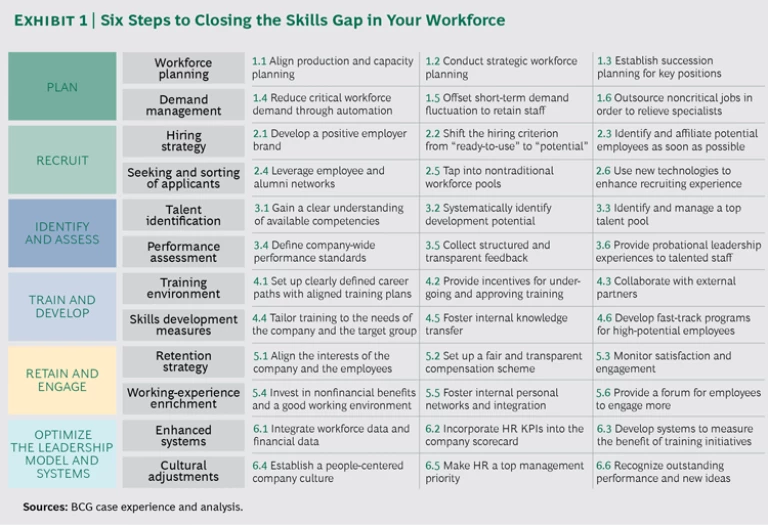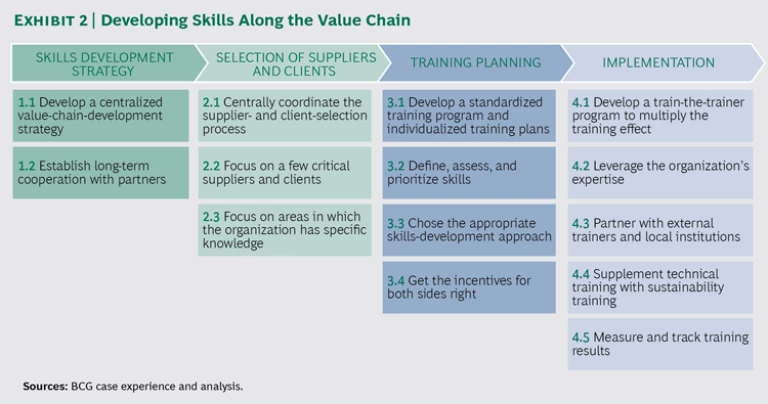One of the most effective ways to fight poverty and boost economic development is through job creation. About 200 million people are unemployed globally. As a result of demographic shifts, there will be a need for
The “skills gap” constrains economic and social development, limiting the ability of individuals to get jobs and improve their living standard; of companies to improve productivity, competitiveness, and growth; and of countries to reach their potential. Particularly in developing countries, the private sector needs to play an active role in closing the skills gap. The public sector—especially education systems—is often too stretched.
Many companies are stepping in to fill the void. A South Asian food, fertilizer, energy, and petrochemical company has cofounded a technical-training college that offers both three-year diplomas and six-month vocational training and provides agricultural-training courses to thousands of small-farm owners. The company also trains women to become milk collectors and agricultural extension workers, opening opportunities in historically male-dominated rural areas. To give back to the community and to improve community relations, the company invests in the education systems in locations where it makes fertilizer, which can be hazardous to produce.
Closing the skills gap requires a combination of various measures. Some are small: when, for example, JMS, a Bangladeshi textile company, started to provide free sanitary napkins, absenteeism fell significantly. Others demand investment. Ohorongo Cement, a Namibian company, set up its own training center to prepare people for jobs as control room operators—for whom there is high demand in the country.
Skills development in the private sector benefits not only the company but also its employees, whose living conditions and job prospects improve, and society, which benefits from the improvements in overall well-being, purchasing power, and tax revenues.
The correction of the skills gap is too important to leave to chance. We have developed a three-level approach to closing the gap: in individual companies, along the value chain, and in the local community. This practical and hands-on approach, which is well suited to small and midsize enterprises in developing countries, consists of the following:
- A user-friendly guide for practitioners that details a six-step approach for recognizing and closing skills gaps
- A collection of proven examples showing how companies close these gaps on the three levels
- An assessment tool that helps companies anticipate potential returns on their investment
Investing in Your Own People: Closing Skills Gaps in the Workforce
Companies that actively and strategically invest in workforce development see huge payoffs in the form of increased productivity, higher product quality, greater ability to adopt new technologies, and higher employee engagement. It is important to note that a comprehensive approach includes more than just training. We’ve broken our approach into six steps: planning, or identifying the need for specific skills; recruiting new employees; identifying and assessing internal skills-development potential; conducting training and development measures; engaging and retaining trained personnel; and optimizing the leadership model and systems. (See Exhibit 1.)
Planning allows organizations to detect potential skills gaps and develop measures to close them, by both increasing supply and managing demand. Increased automation, for example, provides an important lever to reduce the demand for certain skills and narrow the skills gap. Recruiting involves creating sophisticated hiring strategies and developing an employer brand to increase the number of applicants and attract talented people. Identifying and assessing talent covers both understanding the profile of the workforce and developing a structured performance assessment. Training and development ensures that employees have clearly defined career paths that are aligned with training plans. Training should be tailored to close the most critical skills gaps. Retaining and engaging employees is an ongoing process of monitoring the satisfaction of employees and devising strategies to make sure that talented and skilled workers stay and are motivated. Optimizing the leadership model and systems ensures that key executives and leaders actively work on skills development, recognize and value the performance of employees, and make HR decisions on the basis of data.
Skills Development Along the Value Chain
To be successful, companies in developing countries will frequently have to look outside their own organization to solve skills gaps and improve the capabilities of their suppliers, distributors, and clients.
Skills gaps at suppliers constitute a leading cause of delays and inadequate quality. Companies often have the knowledge and incentive to support their suppliers in closing these gaps. What’s more, the development of a local supply in emerging markets has significant benefits for local communities by providing better and more diversified jobs.
Furthermore, in many cases it is helpful to train clients and distributors. Such training can benefit a company when it enters a new market or introduces a new generation of products. The sales and maintenance teams on the ground, for example, need to have a thorough understanding of products and services. Typical measures to bridge skills gaps along the value chain are training courses conducted or sponsored by the company and the transfer of know-how, either by sending experts to work with the company’s suppliers and clients or by bringing their employees on site.
There are a few keys to success at this level. (See Exhibit 2.) First, the organizations should create a skills development strategy that includes establishing a long-term training relationship with partners rather than simply providing ad hoc support. Second, the strategy should focus on a few critical areas with the suppliers and clients that have the largest need for support. Third, organizations need to develop a standardized training plan to lower costs and ensure consistency, but they have to be willing to make adaptations to the needs of specific partners. Finally, organizations need to focus on implementation. A train-the-trainer approach can be a cost-effective and sustainable way to reach a large number of employees.
Closing Skills Gaps in the Local Community
Investments in closing skills gaps in the broader community, often through corporate social-responsibility activities, lead to better community relations, secure the social license to operate, and foster close ties with the government. Additionally, investment in schooling supports the long-term supply of qualified employees.
A company should pursue such activities strategically so that it is not responding to isolated requests for support and donations unrelated to its core competencies. The strategy should identify target sectors and individuals eligible for support, define the objectives and approach of potential projects, and estimate and secure needed financial resources.
Pulling It All Together
Companies multiply the success of their efforts at closing the skills gap when they operate strategically across all three levels. Hape Holding, a German toy company whose main production facility is in Beilun, south of Shanghai, provides a great illustration of this power.
Hape relies on a supply of adequately qualified workers who understand wood as a material and have the technical ability to work on complex machines. Thus, the company has developed a dedicated three-year vocational-training program for wood mechanics to ensure the supply of adequately trained workers. It also depends on the quality of its wood supplies, so the company trains its suppliers to improve the quality and reliability of its supply.
As a large employer in Beilun, Hape has incentive to give back to the local community. Through its community-development activities, Hape runs a “toy experience center,” and it is building a bamboo kindergarten in the company-owned bamboo forest to raise awareness of the educational value of play and to promote nature-oriented activities.
The Boston Consulting Group and the German Development Finance Institution have produced a report that explains this three-level approach2 in greater detail and provides five in-depth case studies. The report was prepared for the Association of European Development Finance Institutions as part of Let’s Work, a global partnership dedicated to providing effective solutions to the global jobs crisis by harnessing the potential of the private sector.











